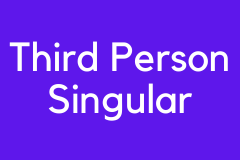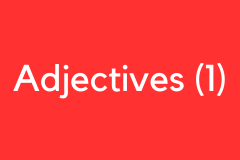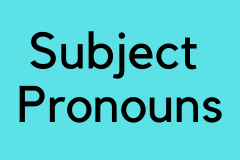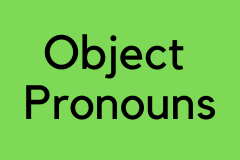Third Person Singular
Learn how to use the third person singular in English.
Answer the following grammar questions.
Present Simple
Third Person Singular
Point 1: The third person singular refers to one person or one thing you are talking about.
Example: he (one man), she (one woman), it (one thing).
Example: he (one man), she (one woman), it (one thing).
- Bob is my boss. He helps me a lot.
- Suzy has a nice car, but she never drives it to work.
- My phone does not take pictures. It does not have a camera.
- This pizza tastes great. It has a lot of calories, though.
Point 2: In the present tense, we add -s to the verb when the subject is third person singular.
Example: He plays soccer. She walks to work.
Example: He plays soccer. She walks to work.
- Larry loves video games. He plays them every night.
- Sue walks to work. She listens to podcasts as she walks.
- My phone needs a new charger. It costs 40 dollars.
Point 3: In negative sentences, change do not to does not for third person singular. In conversation, we usually use the contraction doesn't.
- She does not work nights.
- She doesn't work nights.
- He does not travel much.
- He doesn't travel much.
- It does not snow much in my town.
- It doesn't snow much in my town.
Point 4: In WH questions, change do to does if the question is about the object. The verb in the answer uses -s.
- When does the train leave?
- It leaves at six.
- What does your mom want for her birthday?
- She wants a cat.
- How does your wife get to work?
- She takes the bus.
- Why does he always look angry?
- He has a lot of stress.
Point 5: If the question is about the subject (starting with Who or What), add -s to the verb. Do not use does.
- Who lives here?
- My friend lives here.
- What costs a lot of money?
- College costs a lot of money.
- Who talks to you every day?
- My dad talks to me every day.
- What takes up a lot of your time?
- Driving to work does.
Point 6: In Yes/No questions, change do to does and use does or doesn't in the answer.
- Does he work here?
- Yes, he does. / No, he doesn't.
- Does she have a nice house?
- Yes, she does. / No, she does not.
- Does it rain much in your town?
- Yes, it does. / No, it does not.
About the Teacher
 My name is Todd Beuckens and I am an ESL teacher in Japan.
My name is Todd Beuckens and I am an ESL teacher in Japan.
I created this site to provide teachers and students free audio lessons and learning materials not usually found in commercial textbooks.










